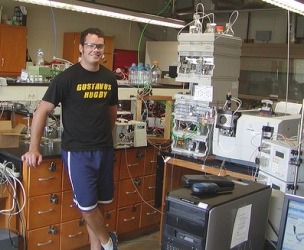Jeremy Bedard
Developing a High Performance Liquid Chromatography Method for the Analysis of Triclosan in Surface Waters
Chemistry, Dr. Stoll

About My Research:
High performance liquid chromatography (HPLC) is an analytical technique used to quantify chemicals at very low concentration. HPLC can efficiently separate different compounds based on their interactions with the particles in a small diameter column. Compounds are then detected most commonly by use of UV-visible absorbance spectroscopy, or mass spectrometry. Triclosan (TCS) is a highly used anti-bacterial found any many soaps and cleaning products. Concern has risen lately due to the high concentrations of TCS in natural waters. These high concentrations lead to adverse effects for the ecosystems they are in. The goal of my project is to effectively and efficiently separate TCS in natural water and detect it at part-per-trillion levels.
In the student's own words :
"I enjoy the one on one attention I have received with my research professor. It’s not too much to the point that I feel I’m not independent, but it’s good to have someone to guide you. I also like the community that has formed in the ten weeks everyone has been here. The students really get together to have a fun summer outside the labs."
Professional Abstract:
Surface water samples contain thousands of compounds present in a wide range of concentrations. In the case of trace analysis of a target compound in a complex sample, the performance-limiting step is typically not the detection of the target analyte per se; rather the performance of the method is heavily dependent on the ability to separate the target analyte from the diverse mixture of other compounds (i.e. the matrix). One way to combat the difficult separation is by using multi-dimensional separations. This approach works by fractionating the injected sample in order to expose the mixture of compounds to multiple chemically and physically different separation media. In this work we describe the development of a multi-dimensional HPLC system for this purpose. Triclosan in surface water has been chosen as a model system to test the effectiveness of this approach. Triclosan is a common anti-bacterial found in soaps, detergents, and other cleaning supplies. Wastewater treatment methods involving chlorination can lead to chlorination of triclosan and its degradation products. The release of the chlorinated derivatives into the environment has caused some alarm as the toxicity of some of these compounds can be extremely high. We will demonstrate the use of this multi-dimensional system to quantitatively separate triclosan in surface water samples and determine its concentration at parts-per-trillion levels.
More student thoughts:
"Research at Gustavus is very personal. By the end of the summer, the relationships with your professor and other researchers are very strong. The research being conducted at Gustavus is just as pertinent and exciting as the research you would find at a big university."
Links:
- Learn more about the Department of Chemistry
- Go to the student's Faculty Research Advisor